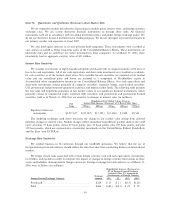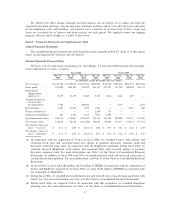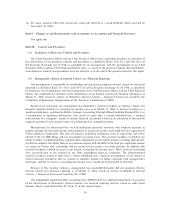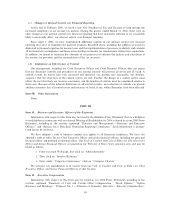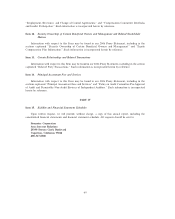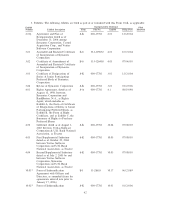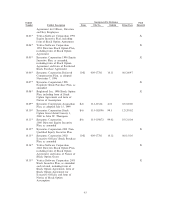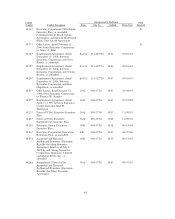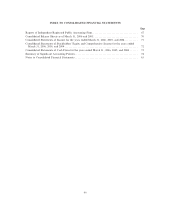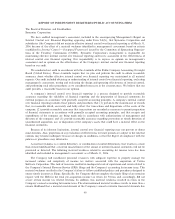Symantec 2006 Annual Report Download - page 64
Download and view the complete annual report
Please find page 64 of the 2006 Symantec annual report below. You can navigate through the pages in the report by either clicking on the pages listed below, or by using the keyword search tool below to find specific information within the annual report.(e) Per share amounts reflect the two-for-one stock split effected as a stock dividend, which occurred on
November 30, 2004.
Item 9. Changes in and Disagreements with Accountants on Accounting and Financial Disclosure
Not applicable.
Item 9A. Controls and Procedures
(a) Evaluation of Disclosure Controls and Procedures
Our Chief Executive Officer and our Chief Financial Officer have concluded, based on an evaluation of
the effectiveness of our disclosure controls and procedures (as defined in Rules 13a-15(e) and 15d-15(e) of
the Securities Exchange Act of 1934, as amended) by our management, with the participation of our Chief
Executive Officer and our Chief Financial Officer, that, as a result of the material weakness described below,
such disclosure controls and procedures were not effective as of the end of the period covered by this report.
(b) Management's Report on Internal Control over Financial Reporting
Our management is responsible for establishing and maintaining adequate internal control over financial
reporting (as defined in Rules 13a-15(f) and 15d-15(f) of the Securities Exchange Act of 1934, as amended)
for Symantec. Our management, with the participation of our Chief Executive Officer and our Chief Financial
Officer, has conducted an evaluation of the effectiveness of our internal control over financial reporting as of
March 31, 2006, based on criteria established in Internal Control Ì Integrated Framework issued by the
Committee of Sponsoring Organizations of the Treadway Commission (COSO).
Based on its evaluation, our management has identified a material weakness in internal control over
financial reporting related to accounting for income taxes as of March 31, 2006. A material weakness is a
significant deficiency, as defined in Public Company Accounting Oversight Board Auditing Standard No. 2, or
a combination of significant deficiencies, that results in more than a remote likelihood that a material
misstatement of a company's annual or interim financial statements would not be prevented or detected by
company personnel in the normal course of performing their assigned functions.
Management has determined that we had insufficient personnel resources with adequate expertise to
properly manage the increased volume and complexity of income tax matters associated with the acquisition of
Veritas Software Corporation. This lack of resources resulted in inadequate levels of supervision and review
related to the our IRS filings and our accounting for income taxes. This material weakness resulted in our
failure to follow established policies and procedures designed to ensure timely income tax filings. Specifically,
we did not complete the timely filing of an extension request with the IRS for the final pre-acquisition income
tax return for Veritas and, accordingly, did not secure certain income tax related elections. In addition, this
material weakness resulted in errors in our annual accounting for income taxes. These errors in accounting
were corrected prior to the issuance of our 2006 consolidated financial statements. The aforementioned
material weakness results in more than a remote likelihood that a material misstatement of our annual or
interim financial statements, due to a failure to complete income tax filings consistent with management's
intentions, and due to errors in accounting for income taxes, would not be prevented or detected.
Because of this material weakness, management has concluded Symantec did not maintain effective
internal control over financial reporting as of March 31, 2006, based on criteria established in Internal
Control Ì Integrated Framework issued by the COSO.
Our independent registered public accounting firm, KPMG LLP, has audited management's assessment
of the effectiveness of Symantec's internal control over financial reporting and has issued an audit report
thereon, which is included in Part IV, Item 15 of this annual report.
58










